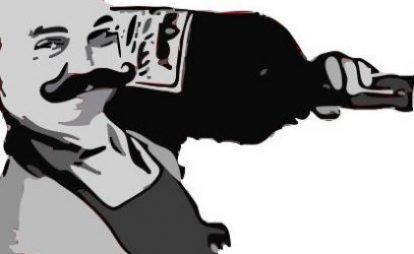The wine industry, a blend of tradition and commerce, has long been a hallmark of cultural identity and economic strength. In Italy, a country synonymous with wine excellence, the sector faces a crossroads, I couldn’t help but think when I read an interesting article by Jeff Siegel last week. He discussed the recent acquisition of Daou Vineyards, which apparently cost Treasury more than one billion US$. Blockbuster deals such as this aren’t the norm though, but a transformation of the wine sector is ongoing. Looking at the US market and using the knowledge what is happening in Italy, we can learn a thing or two from drawing comparisons against the dynamic shifts in the US market to unravel potential future trajectories for Italian vintners and suggest a couple of things how to respond.
The Italian Wine Market: A Surplus Challenge
To understand the status quo of the Italian wine sector, you first need to keep in mind another story that made the headlines a few months ago, the one of Italy’s excessive stock levels: As of mid-2023, Italy’s wine cellars are brimming. With 44.5 million hectoliters of wine, a 4.4% increase from the previous year, alongside a notable surplus in must and new wine, the industry faces a unique challenge. The forecast for 2023 indicates a decrease in wine production by 14%, a scenario reflecting not just agricultural patterns but also market trends. This surplus, coupled with flat sales, shrinking margins, and escalating costs, sketches a complex picture for Italian producers, predominantly small, often family-run enterprises. The generational handover adds another layer of complexity, with younger generations frequently diverging from the vineyard path.
US Market Insights: Mergers and Acquisitions
Across the Atlantic, the US wine market tells a different story, one of consolidation and strategic maneuvering. The year 2023 witnessed significant mergers and acquisitions, with 2024 poised for more action. Despite high interest rates and economic headwinds, the industry leans towards acquisitions to enhance brand portfolios, fill market niches, and navigate the distributor landscape. Key trends include wholesaler consolidation, direct-to-consumer market focus, and an eye on non-US markets, particularly China.
Parallel Paths: Learning from the US Market
The Italian wine industry, while unique in its structure and challenges, can glean insights from the US market’s evolution. The surplus scenario in Italy might prompt a reevaluation of market strategies, possibly considering consolidation, especially among mid-sized producers. The emphasis in the US on brand value and niche fulfillment could inspire Italian producers to diversify their portfolios, perhaps exploring untapped international markets or reinforcing their presence in existing ones.
The Way Forward for Italian Wine Producers
If, in fact, the above said is true, what does it mean in practical terms and how can Italian vintners respond to this? Let’s look at what the future might look like and the several pathways producers ought to consider:
- Increased Mergers and Acquisitions:
Similar to the US, Italy might see a rise in mergers and acquisitions, especially among smaller and mid-sized companies. This trend could help Italian wine businesses to consolidate resources, expand their market reach, and become more competitive. Family-run enterprises, in particular, might find mergers a viable solution to succession challenges and the need for modernization.
- Shift Towards Niche Markets and Branding:
Italian wine companies may need to focus more on niche markets and branding strategies. Given Italy’s reputation for quality and variety, there’s potential to capitalize on unique wine varieties, organic and biodynamic wines, and region-specific specialties. This approach could help Italian companies differentiate themselves in a crowded market and command higher prices for their products.
- Adaptation to Global Market Dynamics:
The Italian wine market will likely need to adapt more aggressively to global market dynamics, including export strategies. Targeting emerging markets, such as China, and reinforcing presence in existing markets can be crucial. This approach requires understanding different consumer preferences and regulatory environments in various countries.
- Direct-to-Consumer (DtC) Sales Focus:
Taking a cue from the US market, Italian wine producers might emphasize DtC sales channels. This shift can help in building brand loyalty, understanding consumer preferences more directly, and enhancing profitability, especially for higher-end and niche wines.
- Financial and Operational Challenges:
High operational costs, including labor and resources, could continue to be a significant challenge. Italian wine companies may need to explore more efficient production methods, invest in technology, and manage finances more strategically, possibly including seeking external investment or partnerships.
- Regulatory and Environmental Considerations:
Italian wine companies must stay vigilant about regulatory changes, both domestically and in export markets. Additionally, environmental concerns and sustainability practices will likely become increasingly important to consumers, influencing production methods and marketing strategies.
- Focus on Quality and Tradition:
Despite the push for modernization and adaptation to new market trends, maintaining a focus on quality and tradition will be crucial for Italian wine companies. This balance between innovation and tradition can be a key differentiating factor in a globally competitive market.
- Increased Competition:
The Italian market could face increased competition, both internally (due to consolidation) and externally (from international players entering the market or through imports). Companies will need to enhance their competitive strategies, possibly through unique marketing, leveraging technology, and enhancing customer experiences.
Not all will apply to everyone and some kind of organizations might be affected more than others, but there can be no doubt that these trends will influence how the Italian wine sector will evolve. To enhance the wine industry’s resilience and growth, it is therefore essential to adopt a multifaceted approach. Exploring new markets, both domestically and internationally, can help mitigate risks associated with surplus and stagnant sales. Smaller producers might consider collaborations or mergers to strengthen their market presence and bargaining power. Embracing modern techniques in viticulture and digital marketing can attract newer generations and global consumers, capitalizing on the industry’s technological advancements. Additionally, leveraging Italy’s reputation for quality by focusing on niche markets, such as organic and biodynamic wines, can provide a competitive edge. Lastly, it’s crucial to understand and respond to evolving consumer preferences, especially among younger demographics, to stay relevant and thrive in a dynamic marketplace.
The Bottom Line
There can be no denial: The Italian wine industry stands at a pivotal point. Even with the recent news of drastic reductions to this year’s numbers, the surplus challenge in combination with generational shifts, and global market dynamics present both hurdles and opportunities. However, all is far from lost: for example, by observing trends in markets such as the US and adapting to the unique Italian context, Italian wine producers can chart a course towards sustainability and growth in an ever-evolving global landscape. In the end, the art of life lies in a constant readjustment to our surroundings.
—
Disclaimer: As always, I’d like to be completely transparent about affiliations, conflicts of interest, my expressed views and liability: Like anywhere else on this website, the views and opinions expressed are solely those of the original authors and other contributors. The material information contained on this website is for general information purposes only. I endeavour to keep this information correct and up-to-date, I do not accept any liability for any falls in accurate or incomplete information or damages arising from technical issues as well as damages arising from clicking on or relying on third-party links. I am not responsible for outside links and information is contained in this article nor does it contain any referrals or affiliations with any of the producers or companies mentioned. As I said, the opinions my own, no liability, just thought it would be important to make this clear. Thanks!




